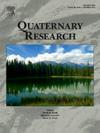Geophysical sediment properties of a late Pleistocene loess–paleosol sequence, Chenarli, northeastern Iran
IF 1.8
3区 地球科学
Q3 GEOGRAPHY, PHYSICAL
引用次数: 0
Abstract
Abstract We present stratigraphic, magnetic, diffuse reflectance spectrophotometric analyses, and chronologic data for the Chenarli loess–paleosol sequence in northeastern Iran. Eight loess units (LU) are identified, described, and constrained in time based on relative stratigraphy and luminescence dating from >130 ± 9.1 ka to ~9.8 ± 0.7 ka. Our data indicate that pedogenic magnetite/maghemite formation gives rise to magnetic enhancement in modern soil and paleosols. The top of LU 7 is demarcated by the well-developed last interglacial soil in which magnetic depletion occurred. We infer that magnetic depletion in this paleosol was produced by reducing conditions in a seasonally waterlogged soil during a warm and wet phase within Marine Isotope Stage (MIS) 5e. Units LU 6 to 1 record several episodes of dust accumulation and soil formation during the last glacial and Holocene. Increased dust accumulation rates occurred during middle-late MIS 3 and lasted into the late MIS 2, with a peak during the last glacial maximum (LU 2). These findings could be applicable to understanding magnetic enhancement/dissolution mechanism in the loess–paleosol sequences in study area. We infer paleoenvironmental changes in northeastern Iran relative to northern Iran, Eurasia, and China.伊朗东北部Chenarli地区晚更新世黄土-古土壤层序的地球物理沉积特征
本文介绍了伊朗东北部Chenarli黄土-古土壤序列的地层、磁性、漫反射分光光度分析和年代学数据。根据相对地层和发光时间(约130±9.1 ka ~9.8±0.7 ka)对8个黄土单元(LU)进行了识别、描述和时间约束。我们的数据表明,成土磁铁矿/磁赤铁矿的形成导致了现代土壤和古土壤的磁性增强。LU 7顶部以发育良好的末次间冰期土壤为界,其中发生了磁衰竭。我们推测,该古土壤的磁耗损是在海洋同位素阶段(MIS) 5e温暖湿润阶段季节性涝渍土壤条件减少的结果。LU 6至LU 1单元记录了末次冰期和全新世期间的几次尘埃积累和土壤形成。沙尘积累速率的增加主要发生在第3期中后期,并持续到第2期晚期,在末次盛冰期(LU 2)达到峰值。这些结果可用于研究区黄土-古土壤序列的磁增强/溶解机制。我们推断伊朗东北部相对于伊朗北部、欧亚大陆和中国的古环境变化。
本文章由计算机程序翻译,如有差异,请以英文原文为准。
求助全文
约1分钟内获得全文
求助全文
来源期刊

Quaternary Research
地学-地球科学综合
CiteScore
4.70
自引率
8.70%
发文量
57
审稿时长
3 months
期刊介绍:
Quaternary Research is an international journal devoted to the advancement of the interdisciplinary understanding of the Quaternary Period. We aim to publish articles of broad interest with relevance to more than one discipline, and that constitute a significant new contribution to Quaternary science. The journal’s scope is global, building on its nearly 50-year history in advancing the understanding of earth and human history through interdisciplinary study of the last 2.6 million years.
 求助内容:
求助内容: 应助结果提醒方式:
应助结果提醒方式:


